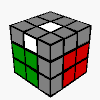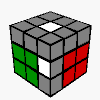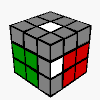Stage 2
Stage 2 strategy:
- Join the 4 squares and orient the remaining edges
- Build 2 corner/edge pairs
- Insert the final 3 edges
- Solve the final 3 corners
Unlike in stage 1 where we focused on one local area at a time, in stage 2 we work on all sides of the cube, and gradually harmonise all of the pieces until the cube is solved.
Joining the squares and orienting the edges
First we will learn how to do these as two separate steps, and then simultaneously.
Joining the 4 squares
If stage 1 is completed correctly, it should be possible to rotate all 4 squares to their solved positions. Below are some examples:
Orienting the edges
For this step, we classify edge orientation as correct, incorrect, or neutral:
| Correct | Incorrect | Neutral | Neutral |
|---|---|---|---|

|

|

|

|
You need to orient the remaining edges so that there are no incorrect edges. That is, you may have correct or neutral edges.
-
Strategy 1 - simple swap
When a neutral edge in the front/middle position is swapped for an incorrect edge on top, the neutral edge can become correct, and the incorrect edge can become neutral.
By applying a series of simple swaps, it is possible to eliminate all of the incorrect edges.
-
Strategy 2 - criss/cross
When many incorrect/neutral edges are bunched together, the criss/cross maneuver can be an efficient way to re-orient them.
-
Strategy 3 - reassigning the free column
By reassigning the free column first, the previous two strategies can be reused on a different column.
This configuration can be fixed by reassigning the free column, doing a simple swap, then returning the free column to its original position.
Reassign the free column plus criss/cross.
Orienting the edges while joining the squares
Now we will learn how to do the previous two steps simultaneously. This is possible because each rotation of a square also has an effect on the orientation of the edges.
In the following table, the top row shows some cases solved in two steps, and the bottom row shows the same cases solved by orienting edges and joining the squares simultaneously:
Separately |
||
Simultaneously |
Building 2 pairs
Using the same techniques learned from stage 1, form two corner/edge pairs. You must do this while preserving the orientation of the edges.
Example:
|
Notice that we can build the two pairs by turning only the red and white faces of the cube. As long as we turn only these two faces, the edges will always remain correctly oriented, because the front edge will always be raised to the top with correct orientation. If instead the white sticker on the front edge were facing in the opposite direction, then we would instead use only the green and white faces to preserve the edge orientation. |
Inserting 3 edges
Once you have two corner/edge pairs, you will need to fit the three remaining edges between them.
Examples:
In this step, it is all-important to follow the positions of the edges, and understand how far away from solved they are. When three of the top edges are in their correct positions (relative to each other), this is actually far away from being solved. When only two edges on top are correct relative to each other, this is actually close to being solved. When no edges on top are correct, this is as far away as when three edges are correct.
To understand why this is so, we need to understand how to manipulate the edges by themselves.
|
In the cube to the left, notice that the blue/white and orange/white edges are in order, but the red/white edge is out of order. Can you see how to solve this position in three moves? (Click play to see the solution) When only two edges are in the correct order, this is the closest position from being solved. |
|
|
Similarily, here two of the top edges are in their correct positions (relative to each other). Can you see which ones, and see how to solve the the edges in three moves? |
|
|
Here, all three top white edges are in the correct order. To be able to solve this position, we first need to take one of the correct edges out of the chain so that we end up in a position that is closer to being solved. Then we can use a usual 3-move solution to finish. |
|
|
Here, none of the edges are correct. First, we try to get exactly two edges correct. Following that, we can use a standard 3-move solution to finish. |
To do the same with corner/edge pairs in the picture, we follow the same general strategy, except that sometimes we will have to take detours to preserve our pairs instead of using the shortest 3-move solution.
| Incorrect | Correct | |
|---|---|---|
|
In this position we observe that exactly two of the top edges have correct positions relative to each other. If we were to ignore the corner/edge pairs that we have formed, we could solve the edges in three moves. But clearly, this will break up one of our corner/edge pairs, as shown in the incorrect solution. However, in the correct solution, we anticipate that our planned three moves will destroy that corner/edge pair, so we move it out of the way. Once the three moves are done, we bring it back. |
The second thing that is all-important in this step is to be aware of the kinds of corner/edge pair that you are building. When you join a corner to an edge, you can either join a corner to the left side of the edge, or you can join one to the right side of an edge. You will find that one kind of corner/edge pair can fit snugly into the front slot, while the other cannot. You will find it much easier to solve this step when at least one (possibly both) of your corner/edge pairs are of the right kind that can fit into that slot.
To become better at this step, study carefully the examples in this section and, if you can keep up with the speed, some of my speed solves in which I use only the simplest techniques.
Solving the last 3 corners
The last 3 corners must be solved simultaneously, without destroying any of the solved part of the cube. Considering that the "solved part" is almost everything, that's quite a challenge!
One way to maneuver just a few select pieces without affecting anything else is to use the principle of commutators and conjugates. A commutator is a sequence of the form X.Y.X-1.Y-1. The idea is that X.Y does half of what you want, but also has side-effects. Then X-1.Y-1 does the other half of what you want, and also undoes those side-effects. A conjugate is a sequence of the form X.Y.X-1. The idea here is that you move the pieces into a position where they are easier to manipulate (X), then you manipulate them (Y), and then you undo the first step (X-1) (see Jaap's Puzzle Page for a more mathematical explanation).
First you will learn a simple method for applying commutators, and then you will learn how to use conjugates to apply those commutators in a more general way.
Commutators
Let's demonstrate the method, move by move.
The first step is to pick any side that has exactly two unsolved corners on it, where one of those corners has correct orientation and simply needs to be moved to the other corner spot on that side. Here, the yellow side is the only choice (notice that the yellow/orange/green corner has correct orientation but just needs to be moved within that side).
Now divide the cube into two halves so that the side you picked with two corners is held in the bottom half, and the side with one corner is in the top half.
What we want to do is pull that yellow corner on the bottom (with correct orientation) out onto the top (let's call that operation X). Then we are going to insert it back into the bottom layer, but in its correct place. Since it already starts with correct orientation, we can just do X-1 to insert it back in, as long as the bottom layer is first aligned ready to receive that corner in the correct position. Let's call aligning the bottom layer Y. So, X.Y.X-1 will pull the yellow corner out, shift the bottom, the insert the corner back in. Now we have to undo the shift so everything returns back to normal. That's X.Y.X-1.Y-1, which is a commutator.
But don't forget we have to solve the other two corners simultaneously. Well, if we solve one of the other corners, the third one must fall into place automatically by the laws of the cube, so we only really have to solve two corners simultaneously. There are 6 different ways to pull the yellow corner out, but only one of those ways is useful to us. We need to pull it out in such a way that the corner on top moves in and takes its place and is solved.
Can you see how to do it? (press play)
Using the principle of the commutator, the rest falls out quite easily:
- X: Moves 1-3
- Y: Move 4
- X-1: Moves 5-7
- Y-1: Move 8
The whole solution is 8 moves instead of the 10 from the first approach.
Let's do another example.
This is a familiar example that perhaps every experienced cubist knows how to solve. But can you "figure out" how to solve it? Maybe now you can! (You can try to solve this cube with your mouse)
Hint: I have oriented the cube the same way as in the previous example, so that you will find two corners on the bottom (one of which is oriented but needs to be moved within the layer), and one corner on top that can be solved in 3 moves. Those are the two corners you should look for before you attempt to solve any position.
And one more.
Can you see how to insert the top corner in 3 moves so that it replaces the oriented corner on bottom?
Conjugates
Sometimes, the 3 corners will not be in a position where we can directly apply a commutator, so we have to position them first, then apply the commutator, then undo the positioning move. This is really what a conjugate is.
We can pick red/white/green as the oriented corner, but the corner to replace it needs to be on the opposite half of the cube. After rotating the right side 180 degrees, we can then apply a commutator (press play). Can you see which commutator to apply?
Here is the full solution. First move the right two corners down to the bottom (call that X), then apply a commutator (Y), then undo the initial positioning move (X-1). That's X.Y.X-1, which is a conjugate. Notice that one move cancels out, so the whole solution is really only 9 moves.
.Another familiar example...
It looks like we could pick any of the three corners as the oriented corner since on the blue side they are all oriented. However, the corner to replace it cannot be inserted in its place in 3 moves. In general, this is easier when the replacement corner has a different orientation from the oriented corner. A better option in this particular case is to consider orientation relative to the yellow/white sides. Then the yellow/orange/blue corner has correct orientation (yellow) and can be easily replaced by the blue/white/red corner.
We can position for the commutator by rotating the right side 180 degrees.
Advanced tips and hints for stage 2
Once you have mastered the individual steps above, you can begin to merge them.
- Instead of solving two pairs and then fitting the final 3 edges between them, it is possible to solve just one pair and solve the other one while doing the 3 edges.
- There are many ways to solve the last 3 edges. Look at the configuration of the last 3 corners also, and you might see a way to solve the edges and corners in one go.
- Watch the last 3 corners carefully while solving the last 3 edges and stop if you see the corners in a good commutator position. Even though you haven't finished solving the 3 edges yet, it is possible to apply a commutator to the corners and then finish solving the edges.